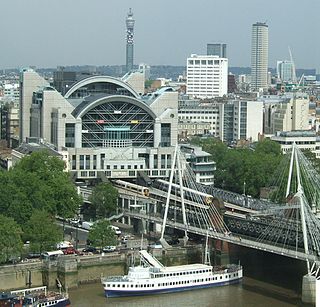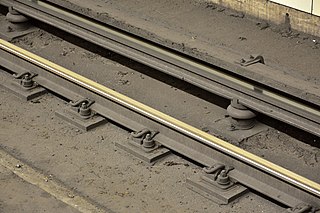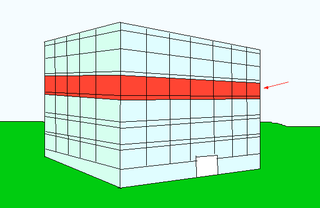
Orpington railway station is on the South Eastern Main Line, serving the town of Orpington in the London Borough of Bromley, south-east London. It is 13 miles 65 chains (22.2 km) down the line from London Charing Cross and is situated between Petts Wood and Chelsfield stations. It is in Travelcard Zone 6.

The North Kent Line is a railway which runs from a junction of Britain's South East Main Line, east of St Johns railway station, Greater London to a point south-west of Strood station by the River Medway in Medway where it links to the Chatham Main Line. The London terminus is Charing Cross station.
The Dartford Loop Line is one of three lines linking London with Dartford in Kent, England. It lies to the south of the other two: the North Kent Line and the Bexleyheath Line.

St Johns railway station is in the London Borough of Lewisham. It is 5 miles 47 chains (9.0 km) down the South Eastern Main Line from London Charing Cross and is situated between New Cross and Lewisham.
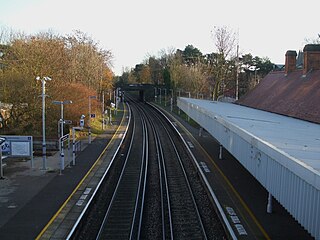
The Catford Loop Line is a railway line in southeast London. It carries a suburban stopping passenger service from central London to Sevenoaks, and is also a relief route for the Chatham Main Line carrying passenger trains from London Victoria to the Kent coast. There is also much freight activity as this is the main route to Willesden and the north via Latchmere Junction, with intermodal traffic from Thamesport and international workings from Dollands Moor.

New Beckenham railway station serves Beckenham in the London Borough of Bromley in south-east London, in Travelcard Zone 4. It is 9 miles 44 chains (15.4 km) measured from London Charing Cross.

Chislehurst railway station is on the South Eastern Main Line, serving the neighbourhood of Chislehurst in the London Borough of Bromley. It is 11 miles 19 chains (18.1 km) down the line from London Charing Cross and is situated between Elmstead Woods and Petts Wood stations.

Hither Green is a railway station located in Hither Green in the London Borough of Lewisham, south-east London. It is 7 miles 16 chains (11.6 km) down the line from London Charing Cross and is situated between Lewisham and either Grove Park or Lee depending on the route.
The Chatham main line is a railway line in England that links London Victoria and Dover Priory / Ramsgate, travelling via Medway.
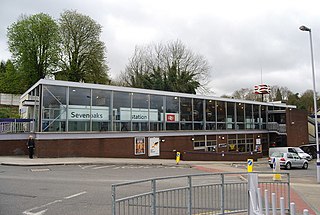
Sevenoaks railway station is on the South Eastern Main Line in England, serving the town of Sevenoaks, Kent. It is 22 miles 9 chains (35.6 km) down the line from London Charing Cross and is situated between Dunton Green and Hildenborough stations. Trains calling at the station are operated by Southeastern and Thameslink.

Tonbridge railway station is on the South Eastern Main Line in England, serving the town of Tonbridge, Kent. It is 29 miles 46 chains (47.6 km) from London Charing Cross via Sevenoaks and is situated between Hildenborough and Paddock Wood on the main line. Trains calling at the station are operated by Southeastern and Southern.
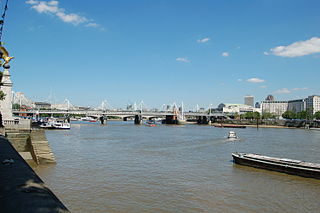
The South Eastern main line is a major long-distance railway route in South East England, UK, one of the two main routes crossing the county of Kent, going via Sevenoaks, Tonbridge, Ashford and Folkestone to Dover. The other route is the Chatham main line which runs along the north Kent coast to Ramsgate and Dover via Chatham.

The Maidstone line is a railway line in Kent, England. It diverges from the Chatham main line at Swanley Junction and proceeds down the Darenth valley to Otford junction. It continues via Borough Green & Wrotham and Maidstone East to Ashford, where it joins the South Eastern Main Line.

The Gravesend West Line was a short railway line in Kent that branched off the Swanley to Chatham line at Fawkham Junction and continued for a distance of 5 miles (8 km) to Gravesend where the railway company constructed a pier to connect trains with steamers. It was opened in 1886 and closed to passenger services in 1953, remaining open to freight until 1968 before reopening briefly between 1972 and 1976. Part of the railway's former alignment was incorporated into the Channel Tunnel Rail Link.





